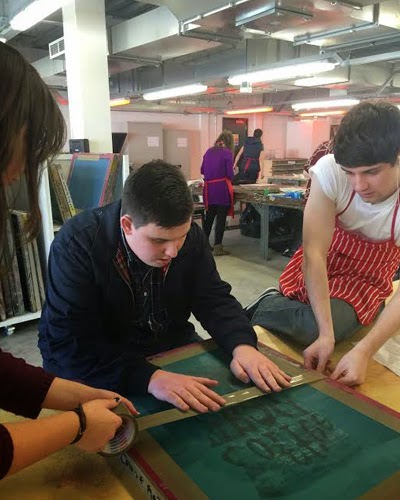1. The first step of the screen printing process was to select our screens and to wash the existing design off. We used a B-Strip chemical and a pressure washer to wash off the design that was already on the screen, we had to cover the screen in a B-Strip chemical before spraying the design off with a pressure washer. We struggled to wash the design off initially and we had to coat the screen in two layers of B-strip in order to completely wash the design off.

2. The next step of the screen printing was to put emulsion on our blank screens. May applied a photo-sensitive emulsion to all our screens instead of us because only a very thin layer of emulsion could be applied to the screen and May had the experience of applying this emulsion.
3. The next step of the screen printing process was to put our designs and our screen into the exposure unit. We used the exposure unit designs onto our screens. The exposure unit uses ultra violet rays to print the design onto the screen.

4. Once our design was printed onto the screen we then had to prepare the screen for the actual printing. The first stage was to print our design on to a piece of paper and this was to teach us how to print the design before we move onto fabric.
5. We then printed our design on to a piece of paper. We create a basic binder using pigments and binder, I created a green binder as this is the ideal colour for my design. I used a squeegee to press the design onto the paper, I had to press the binder across the screen in order to completely cover the entire design. The picture to the right is my first attempt at screen printing and as you can see although you can see the overall design some of the details have not been printed. The main reason why these details were not printed is because we hadn't dried the screen correctly and therefore the design began bleeding.

6. The final step of the screen printing process was to print the design onto the fabric. Firstly we had to wash the binder off the screen with a hose. I then reapplied the green binder to the top of my screen and used the same squeegee to apply the binder across my design. I applied the binder four times across the design because the fabric required more binder then the paper.
Evaluation
I learnt a lot from the screen printing process, I believe that the design on my fabric looks a lot better than the design on the paper. I am happy with my final design but in order to improve it I will need to fill in the gaps with a paintbrush and the same colour binder. On the fabric the gaps in the design aren't as prominent as they are on the paper but they are still recognisable, this is why to improve my design I will need to fill in all the gaps. I believe my final design was effective the only problem with it was that it had a lot of thin lines and this made it a lot harder for me to print the entire design. In order to improve the design I believe I should have filled the gaps in with a paintbrush in order to make the design complete, also I believe I should have printed the actual image in one colour and the title of the design in an other colour.
I believe that my final design will still be popular amongst the target market I identified (young men) because football is such a popular sport across the world, more and more people are becoming interested in the tactics of the game and the managers of each team. However in order to sell my t-shirt to older teenagers (17-21) then I may need to remove the heading "YOU'RE THE BOSS" because older teenagers/ young men will not want to wear a t-shirt with a slogan/ heading on it. However I still believe the slogan will be popular amongst younger teenagers.



No comments:
Post a Comment